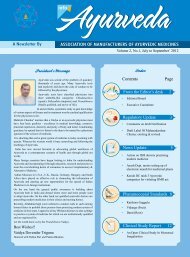Volume 2, No.5, July to September' 2013 - amam-ayurveda.org
Volume 2, No.5, July to September' 2013 - amam-ayurveda.org
Volume 2, No.5, July to September' 2013 - amam-ayurveda.org
You also want an ePaper? Increase the reach of your titles
YUMPU automatically turns print PDFs into web optimized ePapers that Google loves.
Double Blind Randomized Placebo Controlled Clinical Study on<br />
Ashwagandha in Chronic Fatigue Syndrome<br />
INVESTIGATORS<br />
Dr. G. G. Mansharamani, Dr. B. M. Makkar,<br />
Dr. Rachel Koreth, Dr. Gautam Dutta and<br />
Dr. A. Mukherjee<br />
REPORT YEAR: September 1996<br />
1. INTRODUCTION<br />
Chronic Fatigue Syndrome (CFS) is a chronic disorder of unknown<br />
etiology, characterized by persistent lack of drive and energy <strong>to</strong> carry out<br />
day <strong>to</strong> day activities and concentrate on work. The fatigue may worsen<br />
with physical or mental activity, but doesn’t improve with rest. There<br />
is no specific labora<strong>to</strong>ry test and clear criteria <strong>to</strong> identify homogeneous<br />
(sub) groups in patients presenting with unexplained fatigue, and <strong>to</strong> assess<br />
clinical status and disability in patients of Chronic Fatigue Syndrome.<br />
Number of remedies have been tried out with variable results; Work-up<br />
and therapy have <strong>to</strong> be based on this integrated approach.<br />
Ashwagandha (Withania somnifera) known for its beneficial effects in<br />
humans may help for combating stress in the patients with Chronic Fatigue<br />
Syndrome. Therefore, the study on Stresscom Capsule (Ashwagandha<br />
Capsule) was conducted <strong>to</strong> evaluate the efficacy and safety in patients<br />
suffering from Chronic Fatigue Syndrome.<br />
parameters of this study. It was studied by two methods. In the first method,<br />
the patient’s fatigue level was measured on a scale of 0-3, where 0 being<br />
no fatigue and 3 being the maximum fatigue. On the second method, the<br />
number patients achieving a reduction in various level score at the end of<br />
the study was counted and were compared.<br />
Routine investigations e.g. Urine analysis, Chest X-ray PA, Serum<br />
Electrolytes and Alkaline Phosphatase, and other blood parameters were<br />
done before and after the trial.<br />
Decoding was done at the end of the study, Batch B as ‘Stresscom’, and<br />
Batch A was ‘Placebo’.<br />
3. OBSERVATIONS AND RESULTS<br />
A <strong>to</strong>tal of 86 patients completed the study, with 39 in Placebo and 47<br />
in Stresscom group. There were 18 males and 21 females in Placebo<br />
group. Stresscom group had 26 males and 21 females. The drugs were<br />
administered at a dose of 2 capsules at breakfast and dinner given for 8<br />
<strong>to</strong> 12 weeks.<br />
All patients were followed up at 4 week intervals for 8 <strong>to</strong> 12 weeks, along<br />
with medical check-up and investigations. A careful watch was kept for<br />
side effects, if any.<br />
2. MATERIALS AND METHODS<br />
Patients of Chronic Fatigue Syndrome reporting <strong>to</strong> the Medical OPD of<br />
LNJP Hospital, New Delhi were selected for the study after a thorough<br />
physical examination. The patients were explained the purpose of the<br />
study and their written informed consent was obtained.<br />
Patients enrolled in the study were randomly divided in<strong>to</strong> two batches A<br />
and B, matched for age, sex, and disease profile. Stresscom and Placebo<br />
were supplied as identical looking capsules coded A or B. The identity of<br />
the code was sealed till the end of the study.<br />
3.1. PHYSICAL EXAMINATION<br />
There was no significant difference found in general physical examination<br />
between both the groups.<br />
3.2. KARNOFSKY PERFORMANCE INDEX (KPI)<br />
Both Stresscom and Placebo groups have shown improvement in the scores<br />
of Karnofsky Performance Scale Index (KPI) in each visit compared <strong>to</strong><br />
the baseline, however, no significant difference was found on between the<br />
group analysis (Fig 1).<br />
Figure 1: Karnofsky Performance Scale Index in different visits<br />
Patients with malignancy, au<strong>to</strong>immune diseases, tuberculosis, lyme<br />
disease, infectious diseases, AIDS/HIV infection, psychiatric chronic<br />
diseases diagnosed or suggested by his<strong>to</strong>ry, inflamma<strong>to</strong>ry chronic diseases<br />
or chronic hepatitis, neuromuscular diseases like multiple sclerosis<br />
or myasthenia gravis, endocrine diseases like DM, thyroid hypo- or<br />
hyperactivity, adrenal hypo- or hyperactivity, drug dependency, cardiac<br />
disease, GI, hepatic, renal or hema<strong>to</strong>logical disease etc were excluded<br />
from the study.<br />
Score<br />
90<br />
85<br />
80<br />
75<br />
70<br />
Basal<br />
4th Week<br />
8th Week<br />
12th Week<br />
The physical examination like heart rate, blood pressure, respira<strong>to</strong>ry rates,<br />
body temperature and body weight was done before and after the study.<br />
65<br />
Placebo<br />
Stresscom<br />
The patient’s performance was evaluated on Karnofsky Performance Scale<br />
Index. This Scale helps in classification of patients as per their functional<br />
impairment. The index can be used <strong>to</strong> compare effectiveness of different<br />
therapies and <strong>to</strong> assess the prognosis in individual patients. The lower the<br />
Karnofsky score, the worse the survival for most serious illnesses.<br />
The control over the level of fatigue was one of the most important<br />
info Ayurveda, <strong>Volume</strong> 2, <strong>No.5</strong>, <strong>July</strong> - Sept’ <strong>2013</strong><br />
3.3. FATIGUE LEVEL<br />
3.3.1 Control over the level of fatigue – The mean initial fatigue level<br />
was 2.4 ±0.6 and 2.5±0.5 in Placebo and Stresscom group respectively,<br />
which was reduced <strong>to</strong> 2.1±0.6 and 1.7±0.6 after the study respectively<br />
(Fig 2). The difference was significant.<br />
13


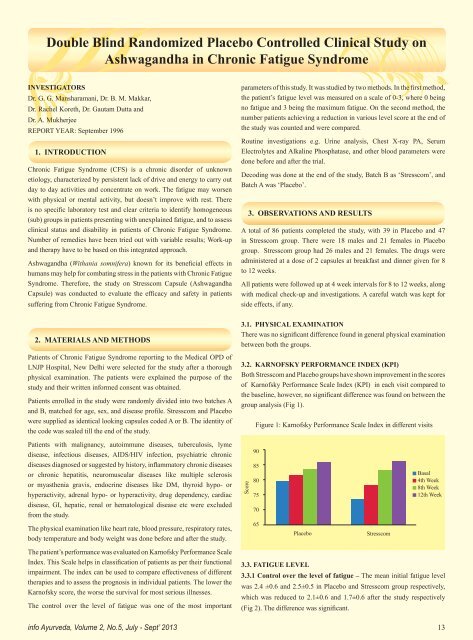

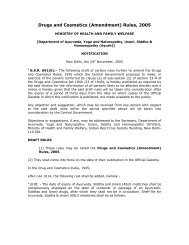
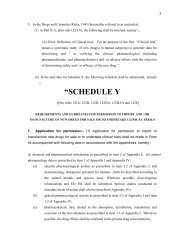
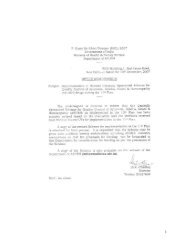

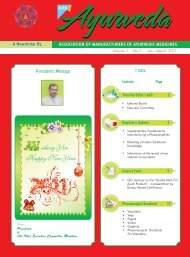

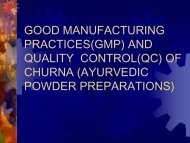
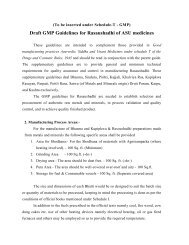
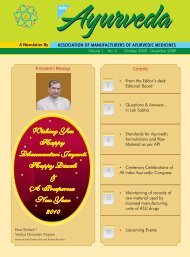
![[To be published in Gazette of India Part II Section 3, sub-section iii]](https://img.yumpu.com/28570283/1/190x245/to-be-published-in-gazette-of-india-part-ii-section-3-sub-section-iii.jpg?quality=85)

